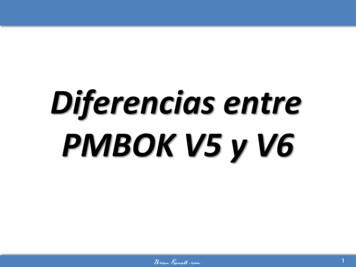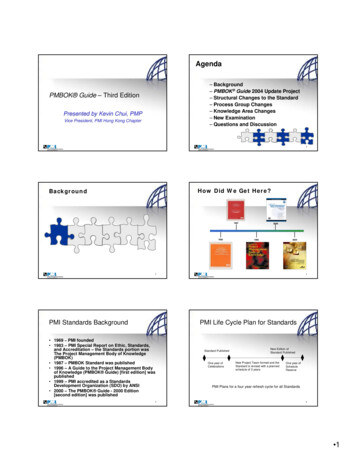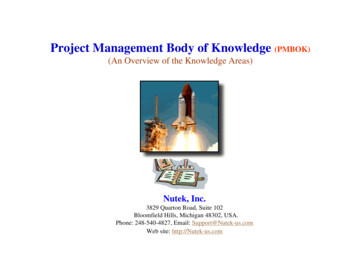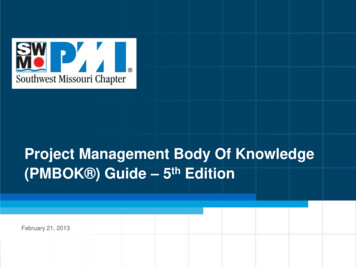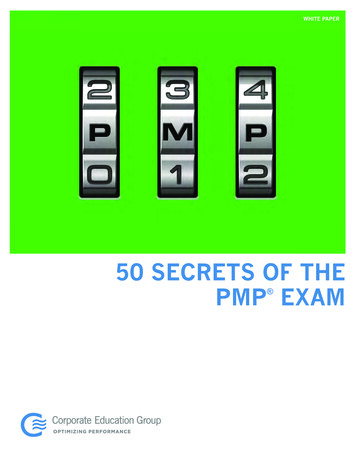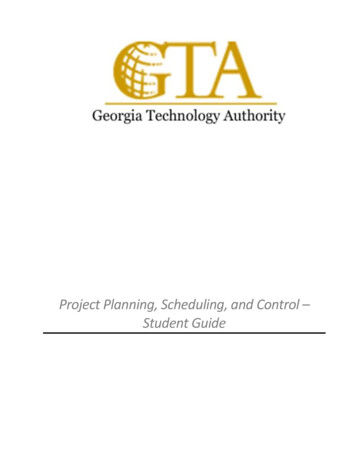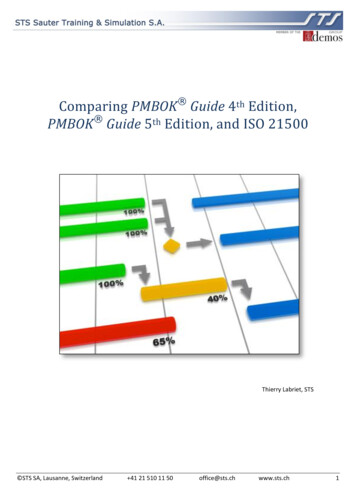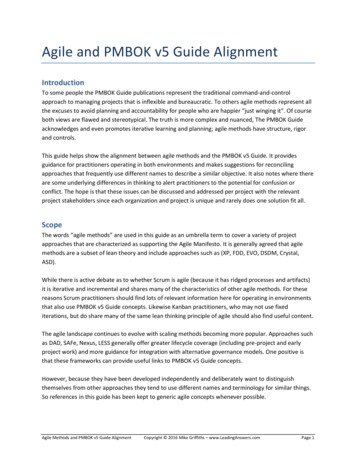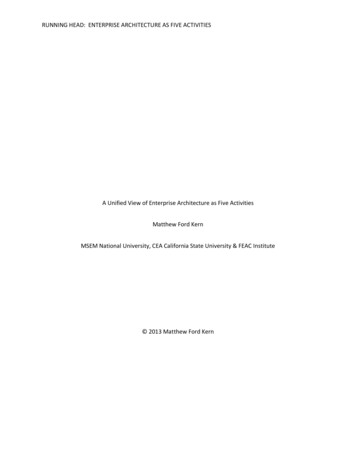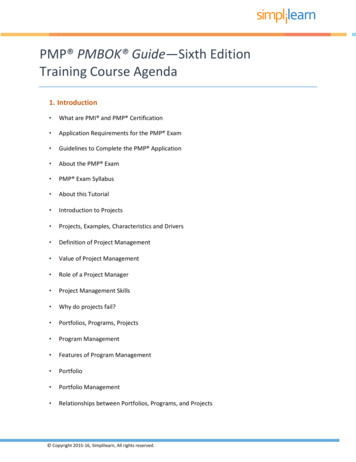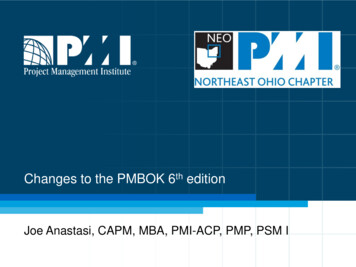
Transcription
Changes to the PMBOK 6th editionJoe Anastasi, CAPM, MBA, PMI-ACP, PMP, PSM I
Project Management Institute (PMI) Founded in1969 by Working Project Managers2
3
Snapshot: PMI Today Over 500,000 members Over 800,000 PMP certification holders 285 Chapters and 20 potential chapters 112 GAC accredited academic programs 10,000 active volunteers Staff in 17 offices (North America, Europe,Middle East, India, China, Latin America, Asia) Active membership in 182 countries and25 territories4
Globally Recognized Certifications Project Management Professional (PMP) Program Management Professional (PgMP ) PMI Portfolio Management Professional(PfMP) Certified Associate in Project Management(CAPM) PMI Scheduling Professional (PMI-SP) PMI Risk Management Professional(PMI-RMP) PMI Agile Certified Practitioner (PMI-ACP) PMI Professional in Business Analysis(PMI-PBA) 5
Benefits of MembershipPMI members have access to a vast collectionof knowledge and career resources, local andglobal communities, opportunities to grow andgive back to the profession, plus discounts,rewards and perks. Complimentary digital PMBOK Guide Free virtual events and webinars Opportunities to earn low or no-cost PDUs Up to 20% off PMI Store purchases Free access to tools, templates and collaborationboards on ProjectManagement.com6
Globally Recognized Standards7
PMBOK Guide Changes
Straight from the 6th editionPMBOK Guide team Link to the video from the PMBOK guideteam.9
PMP and CAPM changes10
New Question Types on CAPM ExamStarting in September In our efforts to continually evaluate and improve the exam-takingexperience, we will present a small percentage of CAPM questiontypes in two new formats:– Matching questions: Test-takers will see two lists (e.g.,project management processes and process groups) and beasked to match items from one list with items from the other.– Multiple choice questions with multiple correct answers:Multiple choice questions with a single correct answer arealready on the CAPM exam. This new question format will asktest-takers to identify a specific number of correct answers.The instructions will tell candidates exactly how many answersthey must select.11
PMP Exam is changing soon Here is the revised content outline– Cross reference of current to new content– content-crossover-map-2019.pdfJune 30, 2020: Last day to take the current version of PMP Exam12
PMP in 2020 has only three newdomains The PMP is evolving just like the profession – and the newexam will focus on three new domains:– PEOPLE – emphasizing the skills and activitiesassociated with effectively leading a project team– PROCESS – reinforcing the technical aspects ofmanaging a project– BUSINESS ENVIRONMENT – highlighting theconnection between projects and organization strategyContent that spans the value spectrum, including predictive,agile and hybrid approaches, will be included across the threeexam domains. The best way to understand what is includedin the exam is to review the updated Exam Content Outline.13
Other changes July 1, 2019: moving to Pearson VUE for all certificationexam delivery to provide more testing locations - over5,000 worldwide. August 28, 2019: The 1,500-hour work experiencerequirement for new CAPM applicants will be eliminated.So you only need the 23 hours education. August 28, 2019: PMI will waive the 35 hours ofeducation required for CAPM holders who apply for thePMP . September 2019: New question types on CAPM Exam.14
What is the PMBOK Guide? PMI provides global leadership in thedevelopment of standards for the practice of theproject management profession throughout theworld. One of their significant accomplishments is theInstitute's evolving standards document - A Guide tothe "Project Management Body of Knowledge(PMBOK Guide)". PMBOK Guide is a globally recognized standardfor managing projects in today's marketplace. The guide is updated every four years and is anANSI standard.15
Why is the PMBOK Guidechanging? Project Management has evolved significantlysince PMI published the PMBOK Guide –Fifth Edition in 2013. The PMBOK Guide is accredited by theAmerican National Standards Institute (ANSI) andmust be updated every four to five years. PMI continually learns more about what drivessuccessful project outcomes through its researchand PMI wants to share those drivers with the projectmanagement community.16
Here are the top revisions This Photo by Unknown Author is licensed under CC BY-SA-NC17
Revision #1: Changes to the name oftwo Knowledge Areas The change of "Project Time Management" to"Project Schedule Management“. We don’t managetime we manage schedules. The change of “Human Resource Management” to“Resource Management” to cover management ofall types of resources – labor, equipment, materials,etc.18
Revision #2: Addition of Three NewProcesses(1.) Manage Project Knowledge:– Manage Project Knowledge is part of theExecuting Process Group and Project IntegrationManagement knowledge area.– This process likely serves to expand the idea ofmanaging information within the project from rawdata to integrated information to knowledge and todecision making wisdom.19
Revision #2: Addition of Three NewProcesses(2.) Implement Risk Responses:– This process is part of the Executing Process Groupand Project Risk Management knowledge area.– This process was previously rolled into the "Direct and ManageProject Work".– Separating this out into its own process gives it the appropriateemphasis.– Why identify risks and complete the analysis withoutimplementing the risk responses?20
Revision #2: Addition of ThreeNew Processes(3.) Control Resources:–This new process is now part of the Monitoring andControlling Process Group and Project ResourceManagement knowledge area.–There was the process "Manage Project Team" inthe previous editions.–However, as every project manager recognizes, it isimportant to assess actual vs. planned usage ofequipment, material, supplies, AND humanresources.21
Revision #3: Changing Name ofNine (9) Processes1.‘Perform Quality Assurance’ to ‘Manage Quality’.2.‘Plan Human Resource Management’ changed to ‘Plan ResourceManagement’.3.‘Acquire Project Team’ to ‘Acquire Resources’.4.‘Develop Project Team’ to ‘Develop Team’.5.‘Manage Project Team’ to ‘Manage Team’.22
Revision #3: Changing Name ofNine (9) Processes6.‘Control Communications’ to ‘ Monitor Communications’.7.‘Plan Stakeholder Management’ to ‘Plan StakeholderEngagement’.8.‘Control Stakeholder Engagement’ to ‘Monitor StakeholderEngagement’.9.‘Control Risks’ to ‘Monitor Risks’.Control sets up a system toinfluence behaviors and activities,and take action.Monitor sets up a system to payattention to project activity, notalways needing further action.23
Process Changes Refer to appendix X1 in the PMBOK . These Knowledge Areas had changes:––––––Integration ManagementSchedule ManagementQuality ManagementResource ManagementCommunication ManagementRisk Management24
Integration ManagementFifth Edition ProcessesSixth Edition Processes4.1 Develop Project Charter4.1 Develop Project Charter4.2 Develop Project Management Plan4.3 Direct and Manage Project Work4.2 Develop Project Management Plan4.3 Direct and Manage Project Work4.4 Manage Project Knowledge4.4 Monitor and Control Project Work4.5 Monitor and Control Project Work4.5 Perform Integrated Change Control4.6 Perform Integrated Change Control4.6 Close Project or Phase4.7 Close Project or Phase25
Schedule ManagementFifth Edition ProcessesSixth Edition Processes6.1 Plan Schedule Management6.1 Plan Schedule Management6.2 Define Activities6.2 Define Activities6.3 Sequence Activities6.3 Sequence Activities6.4 Estimate Activity Resources6.4 Estimate Activity Durations6.5 Estimate Activity Durations6.5 Develop Schedule6.6 Develop Schedule6.6 Control Schedule6.7 Control Schedule26
Quality ManagementFifth Edition ProcessesSixth Edition Processes8.1 Plan Quality Management8.1 Plan Quality Management8.2 Perform Quality Assurance8.2 Manage Quality8.3 Control Quality8.3 Control Quality27
Resource ManagementFifth Edition ProcessesSixth Edition Processes9.1 Plan Human Resource9.1 Plan Resource ManagementManagement9.2 Estimate Activity Resources9.2 Acquire Project Team9.3 Acquire Resources9.3 Develop Project Team9.4 Develop Team9.4 Manage Project Team9.5 Manage Team9.6 Control Resources28
Communication ManagementFifth Edition ProcessesSixth Edition Processes10.1 Plan Communications10.1 Plan CommunicationsManagementManagement10.2 Manage Communications10.2 Manage Communications10.3 Control Communications10.3 Monitor Communications29
Risk ManagementFifth Edition ProcessesSixth Edition Processes11.1 Plan Risk Management11.1 Plan Risk Management11.2 Identify Risks11.2 Identify Risks11.3 Perform Qualitative Risk Analysis11.3 Perform Qualitative Risk Analysis11.4 Perform Quantitative Risk Analysis11.4 Perform Quantitative Risk Analysis11.5 Plan Risk Responses11.5 Plan Risk Responses11.6 Control Risks11.6 Implement Risk Responses11.7 Monitor Risks30
Revision #4: Moved and renamedone process ‘Estimate Activity Resources’ was part of thePlanning Process Group in past editions. The process was renamed ‘Estimate Resources’ andnow associated with Project Resource Management.31
Revision #5: Deletion of oneprocess There were 47 processes in 5th edition PMBOK andnow 49 processes in 6th edition (47 3 – 1) The function of the Close Procurement process hasnow been captured within Control Procurements andClose Project or Phase. Research shows that few project managers have theauthority to formally and legally close a contract.32
Revision #6: Addition of Agile The PMBOK Guide – Sixth Edition willcontain numerous references to adaptive anditerative practices, including agile. This decision was made in response to therequests of PMI’sstakeholders.This Photo by Unknown Author is licensed under CC BY-NC-ND33
Revision #6: The addition of Agile Changes to the content includes:– The practices often used in an adaptive environmentin the front of each Knowledge Area section.– An appendix to The Standard for ProjectManagement on agile and other iterativepractices.– Although, not part of the PMBOK Guide, aseparate practice guide for agile was released withthe PMBOK Guide 6th edition release.34
Revision #7: The role of the projectmanager and PMI Talent Triangle The PMBOK Guide – Sixth Edition will contain anew chapter on the role of the project manager. The chapter covers the PMI Talent Triangle and the skill sets organizations demand. Project managers need to be more competitiveand relevant—technical project management,leadership, and strategic and businessmanagement are all important.35
PMI Talent TriangleValueValueValue! Project Management Institute. All rights reserved.36
Revision #8: Addition of EmergingTrends and Practices PMI has stretched the PMBOK Guide toinclude notonly generally accepted goodpractices, but, also emerging tools,trends,techniques, and practices. This is also a wonderful addition for those who arelooking for industry specific or modern but somewhatuntried approaches to project management.37
Revision #9: Four new sections ineach knowledge area Key Concepts Trends and Emerging Practices Tailoring Considerations Considerations for Agile/AdaptiveEnvironments38
Tailoring As a project manager, you must determine theappropriate methodology, tools, techniques, outputsand life cycle phases to manage the project. Flexing processes and focusing on the customer needsis most important. Sometimes a hybrid approach of methodologies isneeded for different aspects of the work. You will need to address competing constraints of risk,quality, scope, schedule, resources and cost.39
Revision #10: Emphasis on strategicand business knowledge Greater emphasis on strategic and businessknowledge, with a discussion of projectmanagement business documents.40
Revision #11: Add New RiskResponse The new strategy “Escalate Response” provides forPMs escalating risk to the appropriate party so thatthe risk is no longer the PM’s responsibility.41
Revision #11: Add New RiskResponse Once the risk escalated the PM has twooptions:– Removing the risk from the project riskregister.– Keeping the risk in the register but classify therisk as “escalated” or “assigned to XYZ”. Even if you escalate the risk, you may still needto monitor the risk and impact to the project.42
Revision #12: Difference between Communicationand Communications Communication (singular): Communication isbetween two or more people. Communications (plural): artifacts such aspublished emails.43
Revision #13: Changes in Project ManagementPlan Components and Project Documents In PMBOK 5th edition– Project management plan components(procurement management plan,stakeholder management plan etc.)were depicted as the input or output to aprocess. In PMBOK 6th Edition,– Project management plan itself will bedepicted as the input or output.44
Revision #13: Changes in Project ManagementPlan Components and Project Documents Beneath the input/output table, a list ofpotential project management plancomponents is identified. However, the components of the projectmanagement plan that will be inputs orupdated depends on the needs of the project.45
How do these changes affect thePMP and CAPM Exam? The number of processes has gone up from 47 to 49. While that in itself does not predict a difficult exam, anygood PMP certification training must target to train formore "functions" within project management and theirdetails. There are three new processes; Thus, there will be atleast 5-10% of new content to acknowledge in your PMPexam preparation.46
How do these changes affect thePMP and CAPM Exam? Most importantly, there is Agile and Scrum relatedcontent strewn all over the PMBOK Guide and abrand new appendix to expand its coverage. Your PMP Certification depends on learning theterminology, processes, and application of Agilealong with traditional project management.47
Check out the PMBOK appendices X1: Changes to the 6th edition X2: Contributors to the PMBOK X3: Agile X4: Key Concepts for Knowledge Areas X5: Tailoring X6: Tools and Techniques48
Questions?This Photo by Unknown Author is licensed under CC BY-SA49
Thank you50
Complimentary digital PMBOK Guide Free virtual events and webinars . the "Project Management Body of Knowledge (PMBOK Guide)". PMBOK Guide is a globally recognized standard . the PMBOK Guide 6th
